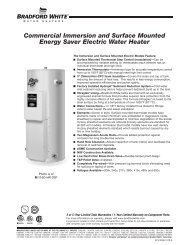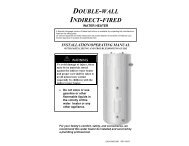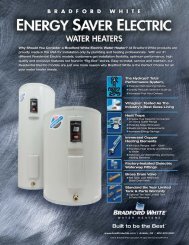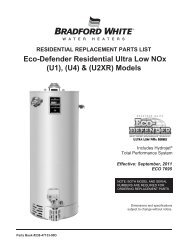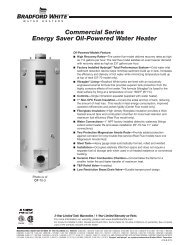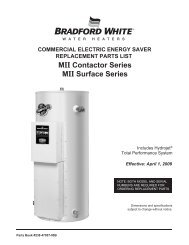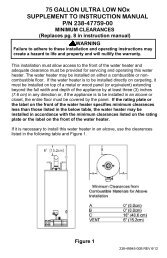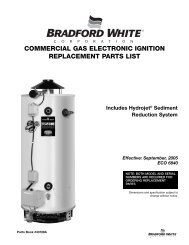238-47104-00A - Bradford White
238-47104-00A - Bradford White
238-47104-00A - Bradford White
You also want an ePaper? Increase the reach of your titles
YUMPU automatically turns print PDFs into web optimized ePapers that Google loves.
SEQUENCE OF OPERATIONNon-Simultaneous and Simultaneous OperationDouble element electric water heaters are designed to operate in a Non-Simultaneous or Simultaneous mode.Non-Simultaneous Mode: Allows only one heating element to operate at a time. For example, when the tank is cold,the upper element is energized first, heating the top of the tank. Only when the upper thermostat is satisfied, the upperelement is de-energized and power is directed to the lower thermostat, energizing the lower element and heating thebottom portion of the tank until the lower thermostat is satisfied. As hot water is drawn off the tank, it is replaced withcold water delivered through the dip tube to the bottom of the tank. The bottom of the tank cools, the lower thermostatwill call for heat energizing the lower element. If enough hot water is drawn from the tank, the top portion of the tankcools and the upper thermostat will call for heat, de-energizing the lower element and allowing only the top element toenergize until the upper thermostat is satisfied.Simultaneous mode: allows both heating elements to operate at the same time. That is, if either thermostat (upper orlower) is calling for heat, the corresponding heating element is energized independent of the other.Sequence of Operation- Double Element, Non-Simultaneous Operation, Single Phase.1234Line voltage is applied across terminalsL1 & L3 of the upper thermostat. ECO isclosed, so there is voltage at terminal L4and to one side of the upper and lowerelements.Tank is cold therefore both thermostatsare closed at terminal T2 & 2 (calling for heat). Thecircuit is complete through the upper thermostatonly, allowing current to flow through upperelement.When upper thermostat is satisfied, it opens atterminal T2 interrupting current flow through upperelement, and closes at terminal T4 allowing voltageto pass to terminal 1 of lower thermostat. Thiscompletes the circuit through the lower thermostatand allows current flow through lower element.When the lower thermostat is satisfied, it opens atterminal 2 interrupting current flow through lowerelement. The system is now in stand-by modewaiting for the next call for heat1 2UpperT’statUpperElementLowerT’statLowerElementECOClosedThermostat closedat terminal T2Thermostat closedat terminal 2UpperT’statUpperElementLowerT’statLowerElement5The lower thermostat/elementcombination will generallycycle on and off more oftenthen the upper. In some cases,such as a cold tank or in highdemand periods, the upperthermostat will call for heat(opening at terminalT4 and closing atterminal T2) prior to the lowerthermostat being satisfied. Thiswill interrupt current flowthrough the lower thermostatand element and allow currentto flow through the upperelement only. When the upperthermostat is satisfied, itresumes operation asdescribed in sequence #3above.Thermostat closedat terminal T43UpperT’statUpperElementLowerT’statLowerElementThermostat openbetween terminals1 and 24UpperT’statUpperElementLowerT’statLowerElementThermostat closedat terminal T2Thermostat closedbetween terminals1 and 25UpperT’statUpperElementLowerT’statLowerElementPage 77



